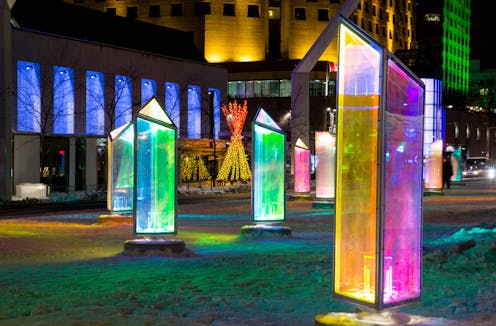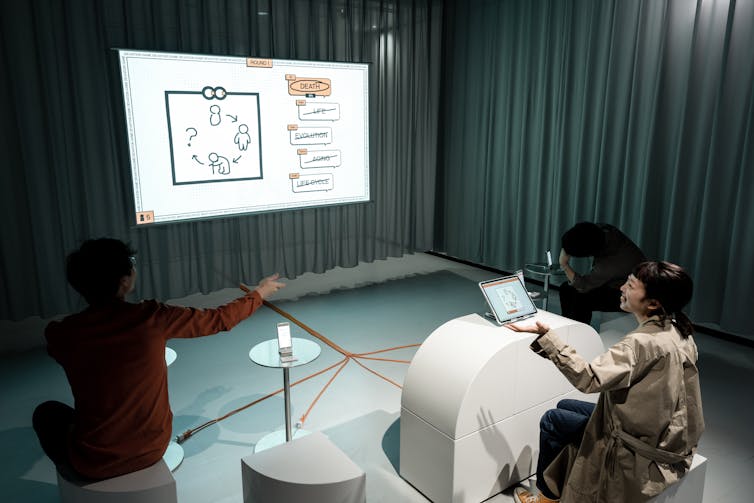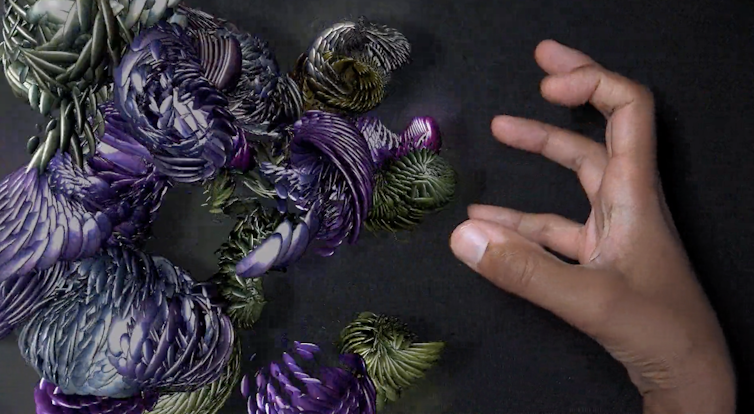
Montréal’s public art program attracts people to specific locations throughout the city, encouraging visitors to linger. This helps stimulate the economy, as people often also visit nearby retailers.
Interactive artworks in Montréal’s public spaces range from audiovisual sound sculptures and light installations to engaging and playful experiences. But while these installations are entertaining, there is often a certain uniformity across these different works.
The rise of social media has encouraged people to look for Instagrammable experiences and TikTok-worthy content. As a result, many public art installations in Montréal have been designed with social media visuals in mind.
Artificial creativity
Artificial intelligence (AI) is increasingly incorporated into every aspect of our lives, including education, business, health, transportation and entertainment.
The art realm also benefits from what AI has to offer. Montréal has featured AI-powered artworks and continues to support arts and innovation. For instance, Faces by digital art studio Iregular uses a facial recognition algorithm that collects images of visitors to create a continuously evolving portrait.
Another Iregular work, Our Common Home, uses computer vision and AI technologies to speculate on the human impact on the planet. Their goal is to create awareness with four installations that are experienced in massive public displays.
Opportunities and dangers
Public spaces can help urban residents engage with the community, make social connections and have exciting experiences. Digital technologies, when incorporated into the public realm, have the potential to reshape the urban experience.
Creating interactions in public space turns the urban space into a playful and social venue that could attract residents of all ages. However, there are challenges when designing interactive urban installations. These include the potential that some people may find installations with an audio component disturbing, installations with lights may be less visible during the day and audience safety must be managed.
Another critical challenge is accessibility. Urban spaces should incorporate universal design principles to support the development of accessible and inclusive public spaces.
Including art in public spaces also raises the question of who the decision-makers and stakeholders are. Often, a government agency commissions local artists for specifically tailored artworks, but some argue for a more democratic approach. Other conflicts could occur, such as whether public art is the right tool to reconstruct public spaces or whether the public should contribute to the artworks.
Interactive installations can increase public engagement and create community dialogues. Diverse AI technologies, such as machine learning and generative AI, can provide dynamic experiences in public spaces.
AI could support the development of urban communities in terms of not only arts but also mobility, education and health care. For instance, AI can directly obtain data from the surrounding environment to create a real-time experience such as intelligent transportation systems, public interactions powered by augmented reality and inclusive, safe and environmentally adaptive structures.
This can even foster learning in the public sphere. The rapidly increasing hype around AI technologies generates curiosity and attracts audiences. Incorporating interactive installations that offer entertaining, educative and exciting experiences could contribute to more equitable and sustainable cities.
On the other hand, adopting AI technologies in the public realm raises issues surrounding consent and privacy and the role of algorithms in society.
Interactive experiences
Even though we are only just started to see AI artworks in the public realm, artists and designers are already using AI’s many features, such as data generation and image processing to create unique works. Specifically, in interactive works, AI enhances the experience by creating stimulating engagements with the audience.
Japanese interaction designer Tomo Kihara and U.K.-based design studio Playfool collaborated on Deviation Game. This multimedia installation includes a digital game that prints the results.
Deviation Game exemplifies a participatory engagement where players digitally interact with each other and the AI algorithm. The game requires players to describe randomly given words by drawing on a screen. The goal is to draw the figures in a way that other human players can guess, while making them incomprehensible to the AI algorithm.

Another example of interactive AI work is Intention by French artist Louk Amidou, which uses generative AI to respond to gestures.
It exhibits an individual engagement mode, allowing visitors to play with the digital forms. Intention uses AI, interaction design, digital art and electronic music to produce a multi-sensory experience.

These two examples create unique and engaging interactive experiences by involving the audience in the creation process.
Playful cities
Artists and public space programmers can take certain actions to create ethically and morally responsible machine learning practices. Computer scientists are developing human-centred approaches to privacy for smart applications, risk assessment tools, data-driven approaches for smart cities and more.
It wouldn’t hurt if interactive urban installations used AI to become more playful, entertaining and even educational. It would reshape public spaces and turn them into engaging activities for locals and tourists. AI certainly promises interesting features for improving these installations, if only being designed responsibly.
Carmela Cucuzzella receives funding from Social Sciences and Humanities Research Council of Canada
Burcu Olgen does not work for, consult, own shares in or receive funding from any company or organisation that would benefit from this article, and has disclosed no relevant affiliations beyond their academic appointment.
This article was originally published on The Conversation. Read the original article.







